Read Part 1 (You don't have to because it is a separate topic):
There is a favorable opportunity in the fashionable trends and climate of "cool" for educators wanting to inspire students to fuse art, design, science and technology. Remember when people said "It's hip to be square?"
Or the Huey Lewis song?
It's an interesting sentiment but it never meant much in academics. That was more about growing out of the free wheelin' hippie lifestyle and into the 80's yuppie lifestyle. When Huey Lewis sang about being "square," he was referring to "Miami Vice" blazers and skinny ties.
But today, Geek
IS the New Black.
It is now fashionable and cool to be geeky. To be clear, I didn't say nerdy, I said geeky; there's a difference.
1
In the last decade there has been a very trendy and growing culture of cutting edge creatives; designers, musicians, and artists, who are fusing their approach with math, science, technology and engineering. These folks are in the forefront of developments from the likes of Google to new start-ups. They are the ones that you read and hear about who are well versed in riding the multi-million dollar waves of crowd sourcing (not surfing) and social media marketing. These are the cool geeks. They are the true Starbucks dwellers. They are hipsters.
Though it pains many hipsters to hear it, it is now the mainstream - at least Apple, Urban Outfitters, Starbucks, American Apparel, Anthropologie and even Target have successfully made it so. Don't think the hipster slacker air is the same as the Seattle Grunge slackers. No, hipsters are often highly educated and intellectual. Beyond the competence porn
2
television shows I enjoy like House and CSI, who'd have thought a sitcom about a group of Cal Tech PHD post doc geeks and engineers would be such a hit -
Big Bang Theory has been running for 4 years and is now THE SECOND most watched television show. Their guests appearances have included absolute Geek Rockstars like,
Stephen Hawking,
Neil deGrasse Tyson,
Brian Greene,
Steve Wozniak, and even
Ira Flatow.
As an educator, I see this as a great opportunity. This is better than student's being able to recognize an Erlenmeyer flask thanks to
Breaking Bad.
In this geek/hipster culture, not only is it COOL to be educated, literate and intellectual, it's also cool to be creative and innovative in ways that intersect with science, math and engineering. Allow me to provide a primer on some of these related subcultures.
Geek Culture
Last year I met an intriguing young woman named Chrissi, who was steeped in a number of counter-cultures, and subcultures. Through her, I learned more about the hipster culture; was introduced to a number of geek cultures, including the makers movement, hacker spaces, cosplay and anime; and that Burning Man is more than just naked people high on X, dancing in the desert (it IS that too).
Chrissi was just as excited to meet with friends at the Science Museum as she was finding an after hours rave. She would quote from Carl Sagan, talk about quantum physics, was an avid participant of Anime conventions, and at the time I met her, was troubleshooting a series of interconnected LED relay switches for an installation/dome/tent for an upcoming Burning Man event.
Hipster Culture
This young woman piqued my interest in the hipster culture. I went to Williamsburg NY to see the home and breeding ground of hipsterdom. Williamsburg is hopping with creativity and enterprise. It is a refined version of the most creative days of the Greenich Village. This is because hipsters are more entrepreneurial than the Greenich village bohemians. My favorite description of hipsters comes from the Urban Dictionary:
"Hipsters are a subculture of men and women typically in their 20's and 30's that value independent thinking, counter-culture, progressive politics, an appreciation of art and indie-rock, creativity, intelligence, and witty banter. The greatest concentrations of hipsters can be found living in the Williamsburg, Wicker Park, and Mission District neighborhoods of major cosmopolitan centers such as New York, Chicago, and San Francisco respectively. Although "hipsterism" is really a state of mind, it is also often intertwined with distinct fashion sensibilities. Hipsters reject the culturally-ignorant attitudes of mainstream consumers, and are often seen wearing vintage and thrift store inspired fashions, tight-fitting jeans, old-school sneakers, and sometimes thick rimmed glasses. Both hipster men and women sport similar androgynous hair styles that include combinations of messy shag cuts and asymmetric side-swept bangs. Such styles are often associated with the work of creative stylists at urban salons, and are usually too "edgy" for the culturally-sheltered mainstream consumer. The "effortless cool" urban bohemian look of a hipster is exemplified in Urban Outfitters and American Apparel ads which cater towards the hipster demographic. Despite misconceptions based on their aesthetic tastes, hipsters tend to be well educated and often have liberal arts degrees, or degrees in maths and sciences, which also require certain creative analytical thinking abilities. Consequently many hipsters tend to have jobs in the music, art, and fashion industries. It is a myth that most hipsters are unemployed and live off of their parent's trust funds.
Hipsters shun mainstream societal conventions that apply to dating preferences and traditional "rules" of physical attraction. It is part of the hipster central dogma not to be influenced by mainsream advertising and media, which tends to only promote ethnocentric ideals of beauty. The concepts of androgyny and feminism have influenced hipster culture, where hipster men are often as thin as the women they date. The muscular and athletic all-American male ideal is not seen as attractive by confident and culturally-empowered hipster women who instead view them as symbols of male oppression, sexism, and misogyny. Likewise, culturally-vapid sorority-type girls with fake blond hair, overly tanned skin, and "Britney Spears tube-tops" are not seen as attractive by cultured hipster males who instead see them as symbols of female insecurity, low self-esteem, and lack of cultural intelligence and independent thinking. Hipsters are also very racially open-minded, and the greatest number of interracial couples in any urban environment are typically found within the hipster subculture.
Although hipsters are technically conformists within their own subculture, in comparison to the much larger mainstream mass, they are pioneers and leaders of the latest cultural trends and ideals. For example, the surge of jeans made to look old and worn (i.e. "distressed"), that have become prevalent at stores such as The Gap, American Eagle, Abercrombie and Fitch, and Hollister, were originally paraded by hipsters who shopped in thrift stores years before such clothing items were mass produced and sold to the mainstream consumer.
Maker Culture
Chrissi also had friends who were grand "tinkerers." This is how I learned of the existence of the
NY Maker Faire, a festival of invention, creativity and resourcefulness, and a celebration of the Maker movement. Here is a description of the Maker Culture from Wikipedia:
The maker culture is a contemporary culture or subculture representing a technology-based extension of DIY culture. Typical interests enjoyed by the maker culture include engineering-oriented pursuits such as electronics, robotics, 3-D printing, and the use of CNC tools, as well as more traditional activities such as metalworking, woodworking, and traditional arts and crafts. The subculture stresses new and unique applications of technologies, and encourages invention and prototyping. There is a strong focus on using and learning practical skills and applying them creatively.
The Artisan's Asylum and Hackerspaces
The Maker Movement has spawned many communal work spaces. One of the largest such spaces is the
Artisan's Asylum in Somerville MA. I have helped to organize a tour of the Artisan Asylum for a group of Math, Science, Computer and Art teachers from Lincoln-Sudbury Regional High this summer. There is also a studio in Providence RI called
AS220. More from Wikipedia:
The rise of the maker culture is closely associated with the rise of hackerspaces, of which there are now over 100 in the United States, and many around the world. Hackerspaces allow like-minded individuals to share ideas, tools, and skillsets. Some notable hackerspaces which have been linked with the maker culture include Noisebridge, NYC Resistor, A2 Mech Shop, Pumping Station: One, Artisan's Asylum, and TechShop. In addition, those who identify with the subculture can be found at more traditional universities with a technical orientation, such as MIT (specifically around "shop" areas like the MIT Hobby Shop). As maker culture becomes more popular, hackerspaces are becoming more common in universities.
NOTE: One section of the Artisan Asylum is occupied by a "nerd biker gang" called SCUL. Part performance art, part kinetic sculpture, funky, and fringe-y, they are quite an interesting bunch. One of the members of the Science department at L-S is an official longstanding member (Not pictured below). You can read about SCUL
here, and this is their
homepage.
Burning Man
Lastly, Chrissi was a member of a "crew"called Acavallo. Acavallo is a team of volunteers who helped to put together a full size pirate ship/carousel/band stand/dance stand with moving horses and gas fired flames. Their project involved design, martketing, recruiting, CAD, engineering, and metal fabrication. Although Acavallo presented their ship at a number of events, the grand event was Burning Man. I had always thought Burning Man was just a Grateful Dead Concert with naked people high on X. Though I've never attended, I've learned that the annual Burning Man event hosts some of the most impressive installations, interactive sculptures and kinetic sculptures I have ever seen (photos of). Highlights of the Acavallo team warrants it's own post - COMING SOON. I will end this post with photographs from various Burning Man events. Keep in mind that one of the main premises of Burning Man is that once it is over, is to leave the Nevada desert without a trace of the event.


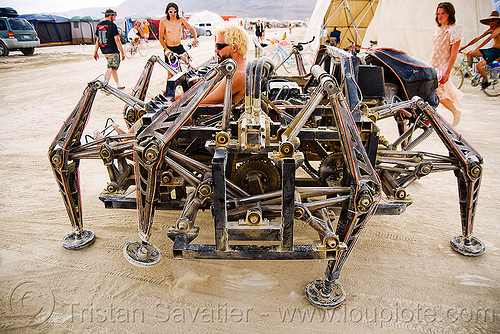
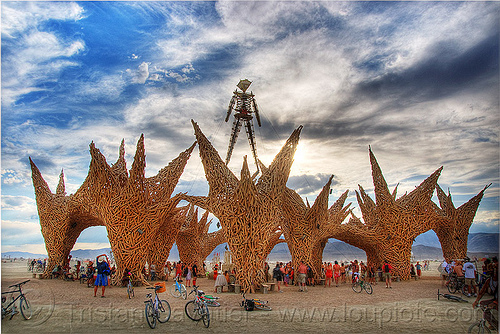

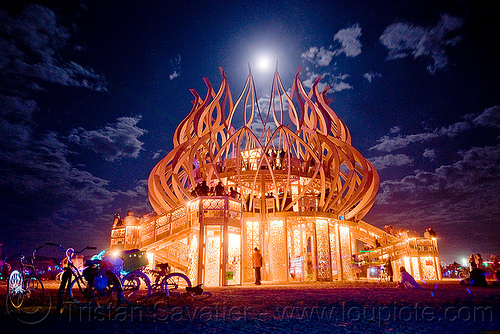
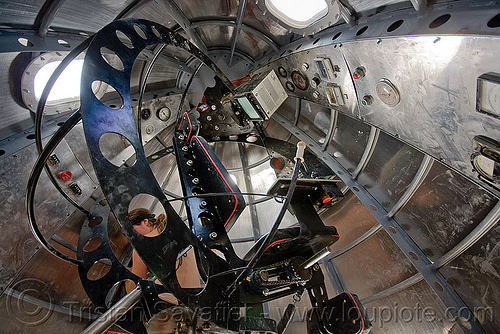





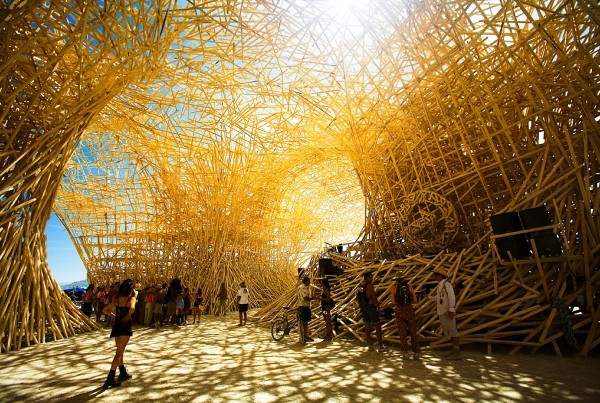

test
1. Hey! this is so cool HTML footnotes! - Geeks are really into specific things, whereas nerds are socially awkward. Of course the two often overlap.↩
2. "Competence Porn" is a term that was coined by screenwriter John Rogers who used the term on his Blog, Kung Fu Monkey↩






























